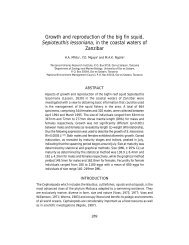gpa_east_africa_case.. - GRID Africa GeoPortal - UNEP
gpa_east_africa_case.. - GRID Africa GeoPortal - UNEP
gpa_east_africa_case.. - GRID Africa GeoPortal - UNEP
Create successful ePaper yourself
Turn your PDF publications into a flip-book with our unique Google optimized e-Paper software.
Solid wastes. It is estimated that about 2,220 tons/day of solid wastes are generated in thecity of DSM. Currently only 23% of the generated quantity is collected and disposed of to theVingunguti crude dumpsite. Smoke, dust and intolerable smell is released to the nearbyresidential areas creating vermin and mosquito breeding, whilst lack of hazardous wastesseparation contaminates ground water resources. Solid wastes are burnt and dumped instreets and open space (Changanikeni, Makumbusho, Mpakani road, etc) that furtherdegrade living and health conditions. It is estimated that 64 million m3 of municipal wastes ayear are disposed of into open channels that percolate into the ground or flow in rivers(Kishimba M. A, and Mkenda A., The Impact of Structural Adjustment Programs and UrbanPollution and Sanitation: Empirical Evidence from Tanzania Major Cities, and Njau G. J. andMugurusi E. K., Towards Sustainable Environment in DSM: AMREF, 1995).Production of solid wastes in the regionSource Quantity (tons/day) 1995 Quantity (tons/day) 2000Domestic 870 1020Market 200 335Industrial 100 240Institutional 80 120Commercial 50 130Street cleaning 40 130Car wrecks 30 50Hazardous wastes 30 110Hospital wastes 25 75Construction wastes 5 15Total 1430 2,220Sources: for year 1995: Kishimba M A, Mkenda A & Njau D J SustainableEnvironment in Tanzania for year 2000: Dump Management at Vingunguti Dump.Soil conditions and the high water table in the city intensify the vulnerability of theenvironment to poor waste disposal practices. Systems for collecting domestic, institutional,commercial and industrial solid wastes are operate inefficiently, if at all. The city centregarbage collection service is now privatised, run by private companies as well as Community-Based Organisations and industries and other commercial enterprises. The Kabuma dumpsiteclose to the Indian Ocean was used until 1988. There have been problem in identifyingsuitable alternative site(s) for final solid waste disposal following the closure of other sitessuch as Tabata, Mbagala Kilungule, Kabuma and Kunduchi as a result of protests fromresidents. Since 1992 a new crude dump at Vingunguti has been used. This dump is locatedat residential area bounded by Msimbazi River and the residential area. The City Council hasearmarked other places for disposing of solid wastes in Kunduchi Mtongani quarries inKinondoni, Mbagala behind Saint Antony Secondary School in Temeke and Pugu Kajiungeniat old Aduco in Ilala. Scavengers search and collect refuse for re-use, some collect and cookfood within the dump, build houses adjacent to the dump and even in the dump itself. Solidwaste flows into Msimbazi River and finally into the ocean. As stated in FAO/<strong>UNEP</strong> MarinePollution in East <strong>Africa</strong> Region:“In Tanzania a few kilometers stretch of Dar-es-Salaam coast is polluted with sewage andindustrial wastes. Faecal lumps and floating solids litter areas around the harbour……..a foulodour due to severe Oxygen depletion of the waters pervades the coastline. The natural floraand fauna within the polluted areas have been smothered” (page 5 para. 88)Agricultural wastes. About 900 sq. km. of DSM are reserved for agriculture. Agriculture isstill a major activity within the city. Application of agro-chemicals, disposal and run-off ofwastes is uncontrolled. Contamination of soils, water sources and valuable resources iswidespread. The national inventory on obsolete pesticides and unwanted chemicalsconducted by NEMC 1997 revealed the presence of piles of stock of obsolete pesticides ofabout 127,000 kg. and 123,000 kg. of veterinary wastes in various water catchment areas orclose to water bodies kept in leaked containers and stores. Soil erosion sediments reach theOcean either directly or through seepage and runoffs or indirectly through the creeks andrivers. The level of concentration of these chemicals and the load of suspended materials inthe rivers and estuaries has not yet been evaluatedFinal Draft Report – Cost Benefit Case StudiesGPA Strategic Action Plan on Sewage, October, 200082



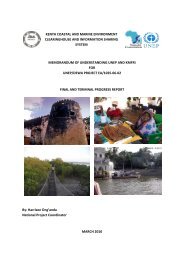

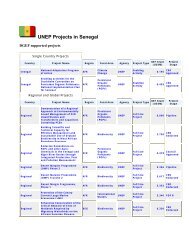

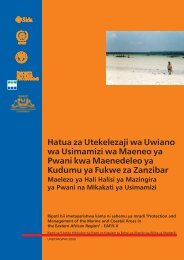
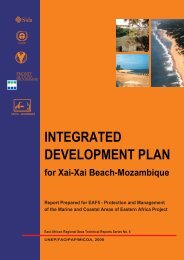
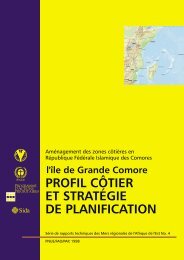
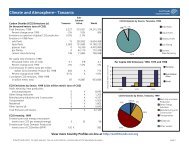

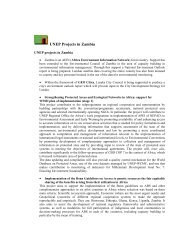
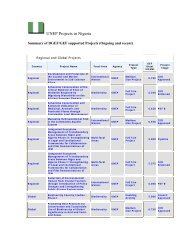
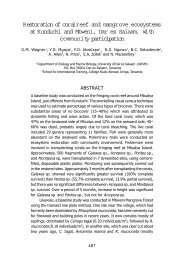
![Please Click to download [English] - GRID Africa GeoPortal - UNEP](https://img.yumpu.com/30633391/1/184x260/please-click-to-download-english-grid-africa-geoportal-unep.jpg?quality=85)
